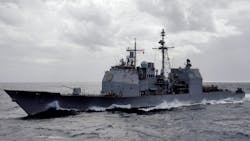Navy asks Lockheed Martin to build TB-37 towed-array sonar for surface warship anti-submarine warfare (ASW)
WASHINGTON – U.S. Navy anti-submarine warfare (ASW) experts are ordering towed-array surface ship sonar systems to enable warships to hunt and attack quiet enemy submarines lurking at a variety of ocean depths.
Officials of the Naval Sea Systems Command in Washington announced a $29.3 million contract modification on Friday to the Lockheed Martin Corp. Rotary and Mission Systems segment in Liverpool, N.Y., to build TB-37 Multi-Function Towed Array (MFTA) sonar systems.
The TB-37, part of the AN/SQQ-89(V) Undersea Warfare/Anti-Submarine Warfare Combat System, is a next-generation passive and active sonar receiver configured as a long 3-inch-diameter array that can be towed behind surface ships. It is for Arleigh Burke-class destroyers, Ticonderoga-class cruisers, the Littoral Combat Ship, and Zumwalt-class land-attack destroyer.
The TB-37 helps surface warships detect, pinpoint, and attack enemy submarines. To build it, Lockheed Martin is collaborating with L-3 Chesapeake Sciences Corp. in Millersville, Md.
The TB-37 MFTA is an active and passive sonar. The towed-array sonar can remain silent and simply listen for the sounds of enemy submarines, or it can ping active to bounce sound off the hulls of submarines in the area.
The TB-37 can operate at a variety of depths to enable surface warships to detect and localize enemy submarines attempting to hide in different ocean layers of varying temperatures and salinity. Ocean layers sometimes can bend sound signals and deceive sonar.
The TB-37 MFTA is the next generation passive and active sonar receiver. It affords several enhancements to the AN/SQR-19 Tactical Towed Array System allowing greater coverage, increased capability and reliability, and reduced obsolescence, Navy officials say.
The TB-37 MFTA significantly contributes to the capability of surface ships to detect, localize, and prosecute undersea threats and is a critical sensor to a combat systems suite.
On this contract Lockheed Martin will do the work in Liverpool, N.Y.; Millersville, Md.; and Marion, Mass., and should be finished by June 2021.
For more information contact Lockheed Martin Rotary and Mission Systems online at www.lockheedmartin.com, L-3 Chesapeake Sciences Corp. at https://www.l-3mps.com/divisions/csc.aspx, or Naval Sea Systems Command at www.navsea.navy.mil.

John Keller | Editor-in-Chief
John Keller is the Editor-in-Chief, Military & Aerospace Electronics Magazine--provides extensive coverage and analysis of enabling electronics and optoelectronic technologies in military, space and commercial aviation applications. John has been a member of the Military & Aerospace Electronics staff since 1989 and chief editor since 1995.

